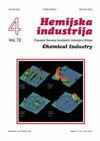原油管道输送主要参数分析
IF 0.8
4区 工程技术
Q4 ENGINEERING, CHEMICAL
引用次数: 0
摘要
本文介绍了原油管道输送主要参数的实验研究和仿真结果。在塞尔维亚,70%的采出油属于石蜡型,其中超过25%的石蜡含量高。高含量石蜡油通常具有高的倾点。塞尔维亚伏伊伏丁那原油中石蜡含量在7.5% ~ 26%之间,原油浇注温度在18 ~ 36℃之间。进口原油有一个流量上限。8 ? C。均质化,即国产原油和进口原油的混合,改善了输送性能,降低了倾点。均质后,对原油进行预热,然后通过管道输送到炼油厂进行进一步加工。加热会改变原油的物理性质,特别是流动性质,从而防止石油管道内形成蜡。本文的目的是确定在实际操作条件下特定石油管道(内径428 mm,长度91,000 m)的操作参数和流动特性。在20 - 50度范围内加热?C,原油的粘度降低,接近水的粘度。管道隔离(100mm厚隔离),埋入地下(1m深)。研究发现,换热系数对管道中油品的冷却速率有主导影响。换热系数主要由隔振厚度决定,故确定+ 100 mm厚度管道换热系数为0.60 W m-2 K-1,非隔振管道换热系数为2.20 W m-2 K-1。通过主管道的热损失范围为36 - 110 kJ m-1 h-1 (10 - 30 W m-1)。原油的起始温度和结束温度之差在10 ~ 12℃之间。当最大流量为0.194 m3 s-1 (700 m3 h-1)时,t = 10℃的降低和粘度的增加导致压降和泵功率明显增加3 - 4%。在固定的热和水力条件下,运输过程中的冷却速率在0.52 ?0.5℃h-1。在国内石油(塞尔维亚伏伊伏丁那)运输的情况下,停机时间不应超过24小时,因为停止和冷却石油将导致固体石蜡颗粒的形成,然后是石油凝胶化。本文章由计算机程序翻译,如有差异,请以英文原文为准。
Analysis of the main parameters of crude oil pipeline transport
The paper presents results of experimental research and simulation of the main parameters of crude oil pipeline transport. In Serbia, 70 % of the produced oil belongs to a paraffin type, of which over 25 % has a high content of paraffin. High-content paraffin oil usually has a high pour point. The paraffin content in crude oil from Vojvodina, Serbia, is in the range 7.5 to 26 %, and the oil pour temperature varies from 18 to 36?C. The imported crude oil has a flow point max. 8?C. Homogenization, i.e. mixing of domestic and imported crude oil, improves the transport properties and decreases the pour point. After homogenization, the crude oil is pre-heated, and then transported by a pipeline to the refinery for further processing. Heating induces modification of crude oil physical properties, especially flow properties so to prevent wax formation within the oil pipeline. The aim of this paper was to determine operating parameters and flow characteristics for a particular oil pipeline (428 mm inner diameter, 91,000 m length) under real operating conditions. By heating in the range of 20 - 50?C, the viscosity of crude oil was reduced, approaching the viscosity of water. The pipeline is isolated (100 mm thick isolation) and buried into in the ground (1 m depth). It is found that the heat transfer coefficient has a dominant influence on the cooling rate of the oil in the pipeline. The heat transfer coefficient is mainly determined by the isolation thickness so that it was determined as 0.60 W m-2 K-1 for + 100 mm thickness, while it was 2.20 W m-2 K-1 for the non-isolated pipeline. Heat losses through the main pipeline ranged from 36 - 110 kJ m-1 h-1 (10 - 30 W m-1). The difference between the starting and the ending temperature of crude oil ranged from 10 to 12?C. Such a decrease of ?t = 10 oC and, consequently, the increase in viscosity induced a noti-ceable increase in the pressure drop and pump power by 3 to 4 %, at the maximum flowrate of 0.194 m3 s-1 (700 m3 h-1). The cooling rate during transportation under stationary thermal and hydraulic conditions is in the range 0.52 ? 0.5 oC h-1. In the case of domestic oil (Vojvodina, Serbia) transport, the downtime should not exceed 24 h, since stopping and cooling of the oil would result in formation of solid paraffin particles followed by oil gelation.
求助全文
通过发布文献求助,成功后即可免费获取论文全文。
去求助
来源期刊

Hemijska Industrija
工程技术-工程:化工
CiteScore
1.60
自引率
11.10%
发文量
12
审稿时长
6-12 weeks
期刊介绍:
The Journal Hemijska industrija (abbreviation Hem. Ind.) is publishing papers in the field of Chemical Engineering (Transport phenomena; Process Modeling, Simulation and Optimization; Thermodynamics; Separation Processes; Reactor Engineering; Electrochemical Engineering; Petrochemical Engineering), Biochemical Engineering (Bioreactors; Protein Engineering; Kinetics of Bioprocesses), Engineering of Materials (Polymers; Metal materials; Non-metal materials; Biomaterials), Environmental Engineeringand Applied Chemistry. The journal is published bimonthly by the Association of Chemical Engineers of Serbia (a member of EFCE - European Federation of Chemical Engineering). In addition to professional articles of importance to industry, scientific research papers are published, not only from our country but from all over the world. It also contains topics such as business news, science and technology news, information on new apparatus and equipment, and articles on environmental protection.
 求助内容:
求助内容: 应助结果提醒方式:
应助结果提醒方式:


